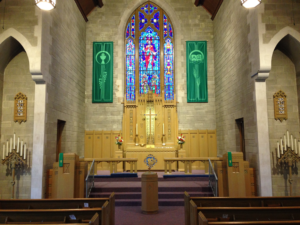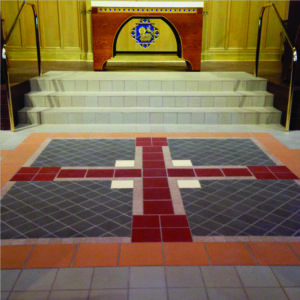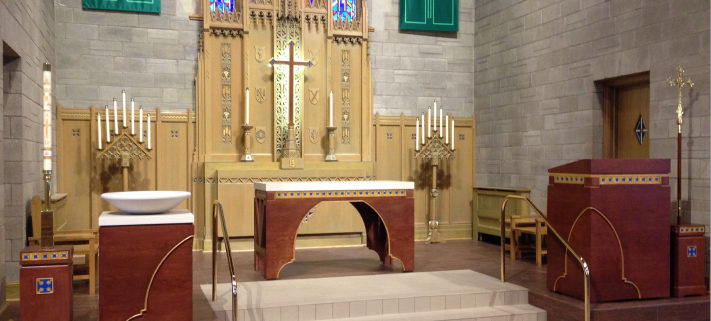Renovation: Green Bay, Wisconsin
Our congregation’s chancel renovation story isn’t a success story. It’s just a story. But it’s a story about God’s work among his people, and that makes it a story worth telling.
A Generous Offer
St. Paul was founded in 1883 by a faithful band of Lutherans who were on the orthodox side of the election controversy. Since 1953, services have been held in mid-town Green Bay in a beautiful, stained glass-bedeckled neogothic building with gray concrete walls reminiscent of a castle. The congregation saw visible growth in the early to mid 20th century, but there was a Protéstant-related shake-up in the early 1980s, and the aftershocks were felt for some time. Though faithful leaders and dedicated laypeople continued to do their best with gifts the Lord provided, and though the congregation continued to enjoy a number of bright moments, a slow and steady decline in membership and worship attendance over the next few decades led some to become worried. Is the Lord still at work among us?
In 2012, a generous member anonymously offered $200,000 in matching funds to renovate the front of the church. There were practical reasons for the offer. The wood finish of the chancel furnishings and reredos were showing signs of age. Communion traffic patterns and a short communion rail meant that Communion distribution occupied an unnecessarily large block of service time. A number of aging members were struggling to climb the three steps into the chancel to approach the rail. Though the person offering the gift preferred that the renovated space look a certain way, he also graciously expressed his desire that the congregation work through the matter, support the effort, and decide how the chancel should look.
Encouraged by the anonymous offer, the conversation attracted more voices, together with more expressions of personal preference, all of which fell neatly into one of two categories, either It’s time for a change! or I wouldn’t change a thing! And while there were practical reasons to renovate, there were also practical reasons to spend money in a different way. An aging building like ours needed attention in other places just to function properly.
But the conversation kept moving forward. Since our aging chancel furnishings were covered by a thin wood veneer that wouldn’t allow for refinishing, and since it was desirable to receive Communion on the main floor level, we talked about new chancel furnishings and new flooring up front. It wasn’t long before we were talking about new flooring for the whole church, more space between pews, a balcony redesign, and lighting improvements. The plan took shape, and the work began. During the renovation we were able to move the pews downstairs to the fellowship hall and temporarily hold services there.
A Principled Approach
A congregation that had seen relatively few changes over the past number of decades now found themselves dealing with a number of changes all at once. It wasn’t just the proposed changes to our worship space. New staff was serving in leadership positions. An increasing number of Latinos and other ethnicities made for a changing demographic in our church neighborhood. Some who had been worried in the past were now excited. But another group was alarmed by so much change, and now they were the ones dealing with the temptation to worry. Is the Lord still at work among us?

Before (See After above.)
It’s the root of all congregational worry, isn’t it? Whether the perception is that the changes are too many or too few: Is the Lord still at work among us?
We knew Scripture’s answer. The Lord was at work among us through his means of grace. There may have been disagreements over how much should be changed, but we all agreed on the blessings of Baptism and the power of Communion. We all believed that God’s Word would not return to him empty. The renovation of font, altar, and pulpit was the perfect time for the congregation to remember the doctrine of the means of grace, and we did so in our sermons, our Bible classes, and our conversations. It was freeing to remember that this project was not primarily about preferences. It was about the Gospel.
It was freeing to remember that this project was not primarily about preferences. It was about the Gospel.
Even our decision about flooring was related to the means of grace. We wanted to let the word of Christ dwell richly in people as they taught and admonished one another with all wisdom through psalms, hymns, and songs from the Spirit (Colossians 3:16). A sound system can help people in the pew hear the preacher up front. But no sound system in the world can help people hear those sitting in the pews around them. We needed a space that was acoustically reverberant. A liturgically-minded acoustical consultant encouraged us to take out the carpet that was in our chancel and in our aisles and to install hard-surfaced flooring material. Some people weren’t so sure about this idea. Some members were afraid church would become too noisy, or that the floor would be slippery in winter. The tech who tuned our sound system counseled us to add carpet, not take it away. Even the workers who installed our new floor said, “Are you sure you want this?” But we stuck to our guns.
We needed a space that was acoustically reverberant.
A Blessing from God
This principled, means of grace-focused approach to our renovation was a true blessing for us all, but from a pastoral perspective it didn’t make the work any easier. Just the opposite. To actively encourage a means of grace emphasis meant being involved with the whole project, which required a staggering time commitment. And the pressure involved in bringing people together sometimes has a way of leaving a leader feeling trapped in the middle.
In fact, as wonderful as the project was, it wasn’t easy for any of us. When a congregation receives a large gift, it is indeed a great blessing from God’s hand, but perhaps not in the way some expect. To those who are given much, much is required. In our setting, people were forced to wrestle with painful questions. Are we too stuck on memories? Are we too intent on making ourselves look awesome? Are we too worried about what other people think of us? Are we not worried enough? Behind them all was one big question that none of us could escape: What is most important to you?
The Lord was uncovering false gods in our hearts and refocusing us on the means of grace.
Through it all, the Lord was at work. He was at work most clearly and most powerfully week after week through his means of grace. This would have been true whether we renovated or not. But he was also at work in the project itself, especially in all the fine messes we got ourselves into. In every discussion and disagreement, he was uncovering false gods in our hearts and refocusing us on the means of grace we intended to highlight in our project. Tears were shed. Forgiveness was spoken.

The cross in the floor assures us of why it is that we sinners can approach God’s throne of grace.
In January of 2016, we dedicated the renovated space with a special service focusing on God’s gracious promise to be present among us in Word and Sacraments. Attractive new ceramic tile covered the whole floor. Lighting in church was not brighter, just less yellow, and the change in hue made everything look better, including printed words on the page. The former altar was now a part of the reredos, and a new free-standing altar stood in the middle of the chancel. The matching pulpit and lectern which had occupied each side of the chancel had been removed and replaced by a new baptism font and ambo. Next to the font stood a paschal candle. Next to the ambo stood a processional cross. The chancel floor design visually connects the altar to the place in front of the first pew from where people would receive Communion. Ambo, font, and altar were finished in a darker color, the color of the church ceiling, to set them apart from the lighter-colored reredos behind them. The cross in the reredos was visually tied to altar, font, and ambo by means of that same color. The reredos and the candelabras in front of it were touched up in their original lighter color. It was a day of thanksgiving and great joy.
An Ongoing Challenge
Now that our project is done, we have an ongoing challenge before us, a challenge we were facing already before the renovation. We can’t let the furnishings and the symbols in our church become more important to us than the message they’re intended to convey. We must continue to find ways to teach the meaning of our symbols and the purpose they serve, lest any of us begin to value created things more than the Creator.
We must continue to find ways to teach the meaning of our symbols.
The challenge isn’t ours alone. Whether you are worshiping with a large, established congregation or with a little band of new Christians, whether your space for gathering is ornate or sparse, people benefit from explanations of why they do what they do and why their church is decorated and furnished the way it is.
The following paragraphs were originally printed in our dedication booklet to explain the symbols in our church. (This booklet, with numerous photos, and the dedication worship folder are available at worship.welsrc.net/download-worship/worship-the-lord-renovation-projects/.)
CROSS: He was pierced for our transgressions—Isaiah 53:5
A cross occupies the central place in our chancel. Our life in this world and the next depends on what Jesus accomplished for us by his suffering and death. By the shedding of his blood, he has atoned for the sins of all people.
FONT: All of you who were baptized into Christ have clothed yourselves with Christ—Galatians 3:27
Martin Luther said, “Baptism is so full of consolation and grace that heaven and earth cannot understand it.” Though a person is only baptized once, Holy Baptism brings daily blessings. Every day our sinful nature needs to be drowned in repentance before God, and every day our Baptism is a resurrection from the dead (Romans 6:3-6). In our struggle against sin, our Baptism tells us who we are, children of God, through faith in Jesus. The victory is already ours. The font is a symbol for all this. Even before a word in church is spoken, the Baptism font speaks for itself.
PASCHAL CANDLE: Because I live, you also will live—John 14:19
Located near the Baptism font, the paschal candle is a symbol of the resurrection. It is lit on the Sundays of Easter and whenever there is a baptism or a funeral. Christ is risen!
ALTAR: This is my body; this is my blood—Matthew 26:26,28
Sacrifices offered on Old Testament altars foreshadowed the one sacrifice by which Jesus atoned for the sins of the world. The altar in our church is more than a table from which we serve Holy Communion. The altar serves as a symbol of Christ’s atoning sacrifice and of God’s abiding presence. Our freestanding altar allows the pastor to face the congregation as he consecrates the bread and wine.
AMBO: The Lord said, “Say whatever I command you”—Jeremiah 1:7
Good preaching takes hard work, but it is not the preacher that gives a sermon its power; it is the Word of God that he preaches. An ambo is a symbol for the proclamation of God’s Word. It functions as both a lectern (from which scripture lessons are read) and a pulpit (from which sermons are preached). When a preacher stands behind the ambo he is inviting the congregation to remember that the message they are hearing from him didn’t originate with him. He is preaching the Word of God.
PROCESSIONAL CROSS: We preach Christ crucified—1 Corinthians 1:23
Next to our ambo is a raised cross, signifying to all that the suffering and death of our Savior Jesus Christ is at the heart of every sermon preached. When the cross is used in procession, we are reminded of Jesus’ gracious promise to be with us who have gathered in his name.
NEW FLOOR: You are a chosen people, a royal priesthood—1 Peter 2:9
Each believer has the privilege and the responsibility of proclaiming what God has done for them in Christ. When believers gather together in worship, that message is begging to be heard from them. By replacing carpeted areas with ceramic tile, we’ve livened our acoustical environment in a way that enables worshipers to hear not only the preacher who stands up in front of them but also the preachers who are speaking and singing in the pews around them.
CHANCEL: The front of our church preaches a sermon without words. Baptism, Communion, and God’s Word are symbolized by three furnishings of matching color. Each of these three pieces is connected in color to the central cross above and behind them. If God’s Son Jesus had not gone to his cross, Baptism could not save us, Communion could not feed our souls, and God’s Word could not set us free. But Jesus has suffered and died for us, and now every promise of God is “Yes” in Christ.
When you come to church and your endurance has been stretched thin by the troubles of this world and your heart is weighed down by sin and guilt, “listen” to that sermon with your eyes. In your baptism, God has proclaimed you his child, clothed in the righteousness of Jesus. In Communion, the Lord sets his table for you and serves you the forgiveness and the fellowship with him for which you long. The Word of God you will hear is the truth, and the truth will set you free. Each of these symbols is located in a space that spills out onto the main floor, on which a tile floor cross invites you and all your fellow worshipers to approach God’s throne of grace with confidence so that you may receive mercy and find grace to help you in your time of need.
A Story Worth Telling
Over a year has passed since our dedication service. Concerns about the floor being slippery or the space being too noisy were completely unfounded. Congregational speaking and singing is noticeably louder and heartier. Replacing the floor provided us an opportunity to install a hearing loop, which has been of benefit for many. We’ve created means of grace focal points by means of color and careful placement and by condensing the pulpit/lectern combination to just one ambo. But what do people think of the chancel? Does everybody like what we did? The majority of people are happy and appreciative of the end results, including many who weren’t so sure to begin with. Still, if everybody loved what we did, it wouldn’t be ministry, would it? Though the debates and arguments have gone away, some are still quietly concerned that too much is changing around here, and others are quietly concerned that we aren’t changing enough. But like every other ministry story, this one isn’t about what people like. It is a story about God’s work among us, and that’s what makes it a story worth telling.
If everybody loved what we did, it wouldn’t be ministry, would it?
Whether you have an opportunity to renovate or not, the Lord is always at work among his people. What a blessing it is to know that his church everywhere will not only survive, it will triumph! Under his blessing, every mess is worth it, every tight spot, every extra bit of effort expended to bring God’s people together around what is most important each week. Our labor in the Lord is not in vain!
By Jon Zabell
Pastor Zabell serves St. Paul, Green Bay, WI. He is chairman of both the WELS Commission on Worship and the WELS Hymnal Project and is a consultant for the synod’s Schools of Worship Enrichment. He was a member of the Hymnal Supplement Committee and chaired the Supplement Introduction Committee.
[fbcomments num=”5″]



